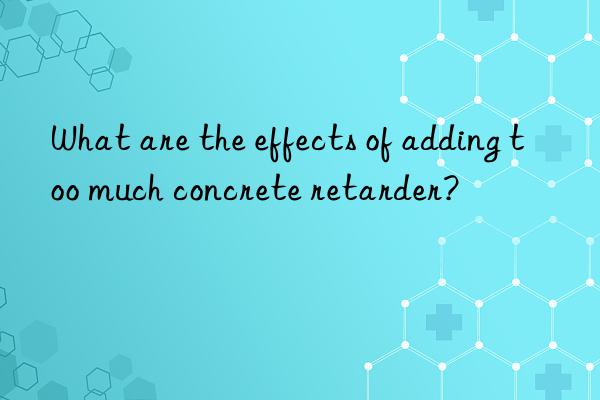
Since admixtures can improve and adjust the properties of concrete, admixtures are used more and more widely in engineering. However, improper use of admixtures not only fails to improve and adjust the properties of concrete, but may even greatly affect the performance of concrete. Cause engineering accidents, this article puts forward some problems and corresponding measures in the use of concrete admixtures.
Concrete admixtures, referred to as admixtures, refer to substances added to improve and adjust the properties of concrete. Since admixtures can improve and adjust the properties of concrete, admixtures are used more and more widely in engineering. However, improper use of admixtures not only fails to improve and adjust the properties of concrete, but may even greatly affect the performance of concrete and cause engineering accidents. , this article puts forward some problems and corresponding measures in the use of concrete admixtures.
1. When using concrete admixtures, do not select the "optimal dosage" through trial mixing
1.1 Consequences
The dosage of admixtures in concrete is related to Compared with sand, stone, cement and water, although it is small, it has a significant impact. To the performance of concrete (such as workability, strength, setting time, etc.) and economic indicators. Especially when adding retarder, retarding water-reducing agent, and air-entraining agent, the dosage will not be effective if the dosage is too small. Once the dosage is exceeded, the poured concrete will not solidify and harden or the strength will be seriously reduced, causing engineering accidents.
1.2 Corresponding measures
(1) The amount of admixture should be expressed as a mass percentage of the total mass of the cementitious material (cement cow admixture) in the concrete or in mL /kg cementitious material expressed.
(2) The appropriate dosage of admixture (water-reducing agent) is reflected in the fact that when the dosage is small, the fluidity of the concrete mixture increases less; when the dosage is too much, the fluidity does not improve. If the ratio increases disproportionately, the fluidity of the mixture will be significantly improved. The suitable dosage range is the interval between the rising section and the gentle upper section, similar to a "saddle shape". There are certain rules for the dosage of different types of admixtures. Usually, the dosage of inorganic salt early strength agent is 1﹪~2% of the mass of the cementitious material; the dosage of organic retarder is 0.02﹪~0.1﹪; air entrainment The dosage of the agent is 0.02﹪~0.1﹪; the ordinary water-reducing agent is 0.2﹪~0.3﹪; the high-efficiency water-reducing agent is 0.5﹪~1.0%. The dosage of the same kind of admixture when used in different concretes is also different. For example, when the superplasticizer is used in steam-cured concrete, the dosage is 0.3﹪~0.5﹪, when it is used in ordinary concrete, the dosage is 0.5﹪, and when it is used in flowing concrete, the dosage is 0.5%. The dosage for normal concrete is 0.75%, and the dosage for high-strength concrete is 1.0%. When the sodium sulfate early strength agent is used in steam-cured concrete, the dosage is 1.0%. If the dosage exceeds 2%, the specimen after steam-curing will swell and the strength will decrease. In addition, the dosage of composite superplasticizer is half that of single superplasticizer at the same water reduction rate. The post-mixing method not only reduces the amount of superplasticizer, but also has the same effect on other admixtures.
(3) There are many factors that affect the dosage of admixtures, such as cement type, fineness, mineral composition, and mixed materials. For example, the dosage of high-efficiency water-reducing agent for slag cement is less than that of ordinary Portland cement. The dosage of cement superplasticizer with large surface area and high C3A content should be more; the initial fluidity of the mixture, temperature, etc.
2. Not paying attention to the compatibility of admixtures and cement (adaptability issues)
2.1 Consequences
Adaptability of concrete admixtures to cement The concept of adaptability and unsuitability: According to the technical specifications for the application of concrete admixtures, a certain admixture that has been tested to meet the relevant standards is added to the concrete prepared with cement that can use this type of admixture according to regulations. If it can produce If the desired effect is achieved, the cement is compatible with the additive; on the contrary, if the desired effect cannot be produced, there is incompatibility between the cement and the additive. For example, several ordinary Portland cements are used and mixed with a certain high-efficiency water-reducing agent (which has been tested to meet the quality standards of high-efficiency water-reducing agents) to prepare concrete. When the preparation conditions are the same, the concrete prepared by one kind of cement is in There is a serious deficiency in water reduction rate, which means that this cement is not suitable for the high-efficiency water-reducing agent, while other cements are suitable for the high-efficiency water-reducing agent. For another example, when an accelerating setting agent that has been tested and meets the requirements of relevant quality standards is added to the concrete prepared by a certain cement but no quick setting effect is obtained, or a retarder is added but a false setting effect is obtained, it can be considered as Due to the incompatibility between admixtures and cement.
2.2 Corresponding measures
The compatibility of cement and admixtures is a very meaningful scientific issue, and it is also a practical engineering issue. This issue arises from engineering accidents. Therefore, production units and engineering application departments must attach great importance to it.
</p

 微信扫一扫打赏
微信扫一扫打赏

